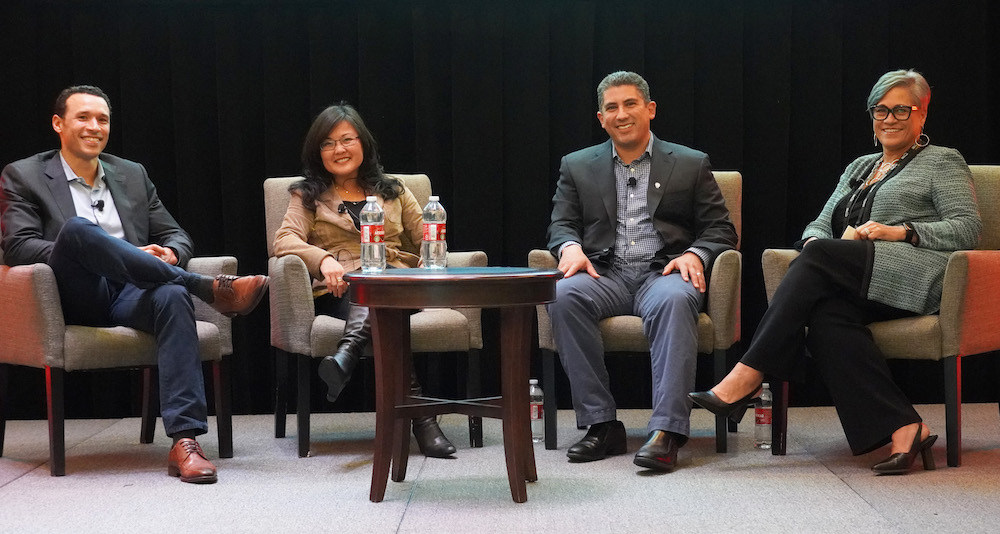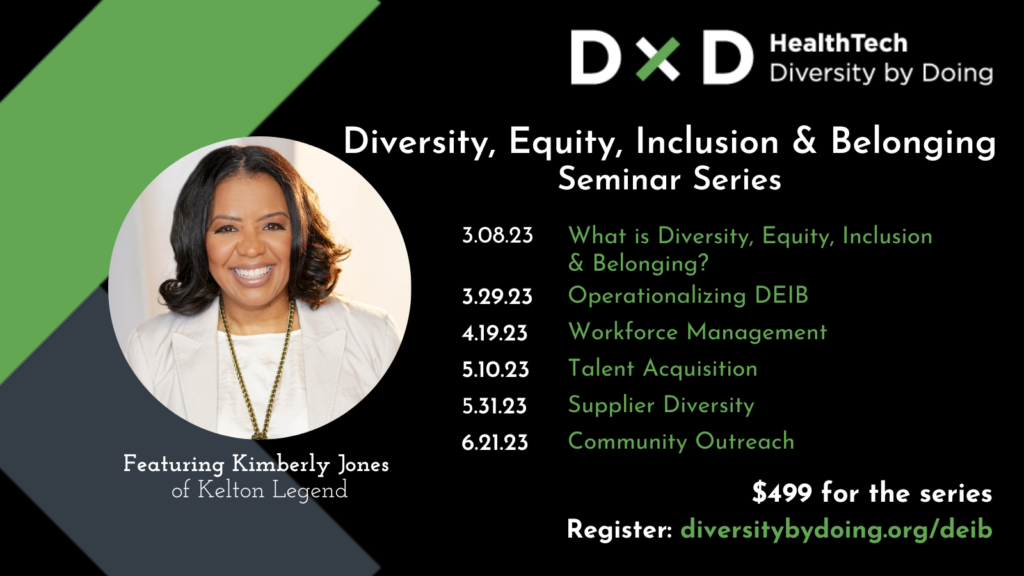Young medtech companies seek high-performing talent for obvious reasons. So creating a company culture that embraces diversity, equity, inclusion and belonging from the get-go can ensure that the company attracts top talent – and is positioned for economic success. At the MedTech Strategist Innovation Summit San Francisco on November 15, 2022, DxD executive director Ingrid Ellerbe moderated a panel on “Operationalizing Diversity: What young companies are doing and what’s next.”
The discussion featured Gabriel Sanchez, CEO and co-founder of Enspectra Health, which developed a “virtual biopsy” technology that’s currently in clinical trials; Tracey Dooley, partner at Avestria Ventures, which funds seed and early-stage companies focused on female founders or women’s health; and Matt McLean, CEO of Half Moon Medical, which is developing a novel approach to repairing mitral valves.
Here are key takeaways from their conversation:
Be intentional with your company culture.
The panelists agreed intentionality and action are essential when it comes to fostering diversity in the healthtech ecosystem. Without intentionality, the healthtech ecosystem developed obvious inequities.
“As a scientist, if we don’t like the outcome, we have to change the conditions of the experiment, or we have to change the equation,” said Sanchez.
McLean said inclusion and belonging have been focal points for his company, which currently employs 19 people from eight countries.
“It’s just been great to see people bringing in their full selves and sharing their culture — not only being willing to, but being excited to share their different cultures and to share whether it’s food or holidays, whatever it is. It’s just people enjoy spending time together and working together. And I think that’s because we’ve created this safe, respectful, accepting environment and ultimately, people do their best work in that type of a situation.”
Diversity makes business sense.
Dooley pointed out that as an investor, her interest in a startup’s diversity is based on economics, not charity. “We believe that this is a clearly beneficial business decision,” Dooley said. “And so we appreciate companies that are being intentional about how they set up as well.”
And, of course, research has shown that diversity makes teams smarter.
“We work in a space where we have to be really creative and good ideas come from everywhere and I think having a range of diverse opinions and experiences around the table will ultimately generate the best ideas,” McLean said.
Diversity can improve health equity.
The fact that pulse oximeters don’t account for skin pigmentation which leads to patients with darker skin receiving less supplemental oxygen, became widely known during the COVID-19 pandemic, Ellerbe pointed out. Skin color is also a factor for Enspectra Health’s technology, which uses imaging to detect cancerous cells.
“Because I have darker skin, and just by virtue of early days prototyping and testing the device to make sure it works and using it on myself … our technology has the ability to image broadly across all different skin tones,” says Sanchez. “Dermatology is rife with examples of falling into these traps where you get primarily type two Caucasian skin, and that may not be then useful and representative for the broader community. And we’re seeing this actually really manifest in as we move into machine learning and we start training on those data sets that when there’s bias that’s built into the data sets, it gets passed directly to the algorithm actually encoded — because we don’t program these algorithms, we teach them. So we see that as an opportunity. It’s a burden and an opportunity.”
But skin color just one example of how race, gender and social factors impact health.
Dooley pointed out that diagnoses and treatments have historically been geared toward men. For example, because their symptoms are different, women are 50% more likely than men to be misdiagnosed for heart attacks. And heart valve replacements have traditionally been designed with a size and shape to suit men, not women.
“The statistics really bear out that when we think about women’s health, it’s not just contraception, it’s not just fertility,” Dooley said. “Obviously, those are areas that are in all markets but it’s really all in healthcare.”
The FDA is paying attention.
The FDA is starting to take a closer look at the patient diversity, or lack thereof, when companies submit data from clinical trials, Dooley pointed out. Large healthcare companies and pharmaceutical companies, too, are impressing upon their suppliers that diverse data is going to be essential to keeping products on the market.
“I think that folks are really starting to see that there is enormous value to that as a business case as well,” Dooley said. “When you start building things in the right way and you build intentionally and build this culture of trust, then that sets you up really well to have those conversations with strategics, with partners at that point.”
Representation matters.
“I went to 12 years of college at two universities and never had a single Hispanic professor,” said Sanchez. “That’s something that could be really important for people who might be missing or who we’re losing the cracks.”
Dooley agreed. Part of the reason she left her career in academic medicine is because of lack of representation: “I looked at everyone who was in a position I might be in, I said, none of you look like me and none of you are going to have the same path that I would have to go through to get there.”
Create opportunities.
“It’s important to take a step back and be able to say, ‘How do we pull people up the ladder after ourselves?’ If we’re following in other people’s footsteps, we need to have that grace to expand our network and give people chances, too,” Dooley said.
In addition to traditional social advantages like wealth, race and gender, McLean pointed out the importance of access. He benefited from a robust network at Stanford University. “Having access to all these incredible mentors and advocates — some of whom are here today – throughout my career who have really helped elevate me and pushed my career forward,” McLean said. “A lot of people don’t have that. So, for me, it’s [a question of] how can we help expand that and give more people those opportunities?”
Enjoy the journey.
Panelists said that creating diversity, equity, inclusion and belonging in a company culture is an ongoing journey, not a destination. “It’s good to have goals, it’s important to have goals because you need things to measure, but it will always be a process,” said McLean. “Just starting that conversation internally, what should we be doing and what can we be doing? Because it will be good for the company and it’s also the right thing.”
Sanchez said he approaches DEIB with intellectual curiosity. “You study this even like any other subject you would study. And as you become educated on it and broaden your perspective and … you realize how much more there is to learn. So I’m actually pretty excited and I look forward to that.”
Interested in doing more to operationalize diversity in your healthtech company? Explore our 2023 Diversity, Equity, Inclusion & Belonging Seminar Series.


